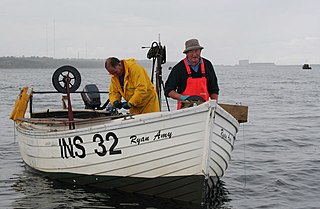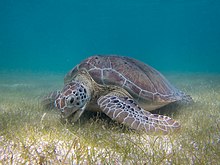
Sea turtles, sometimes called marine turtles, are reptiles of the order Testudines and of the suborder Cryptodira. The seven existing species of sea turtles are the flatback, green, hawksbill, leatherback, loggerhead, Kemp's ridley, and olive ridley. Six of the seven sea turtle species, all but the flatback, are present in U.S. waters, and are listed as endangered and/or threatened under the Endangered Species Act. All but the flatback turtle are listed as threatened with extinction globally on the IUCN Red List of Threatened Species. The flatback turtle is found only in the waters of Australia, Papua New Guinea, and Indonesia.

Cheloniidae is a family of typically large marine turtles that are characterised by their common traits such as, having a flat streamlined wide and rounded shell and almost paddle-like flippers for their forelimbs. They are the only sea turtles to have stronger front limbs than back limbs. The six species that make up this family are: the green sea turtle, loggerhead sea turtle, olive ridley sea turtle, hawksbill sea turtle, flatback sea turtle and the Kemp's ridley sea turtle.

Trawling is an industrial method of fishing that involves pulling a fishing net, that is heavily weighted to keep it on the seafloor, through the water behind one or more boats. The net used for trawling is called a trawl. This principle requires netting bags which are towed through water to catch different species of fishes or sometimes targeted species. Trawls are often called towed gear or dragged gear.

Longline fishing, or longlining, is a commercial fishing angling technique that uses a long main line with baited hooks attached at intervals via short branch lines called snoods or gangions. A snood is attached to the main line using a clip or swivel, with the hook at the other end. Longlines are classified mainly by where they are placed in the water column. This can be at the surface or at the bottom. Lines can also be set by means of an anchor, or left to drift. Hundreds or even thousands of baited hooks can hang from a single line. This can lead to many deaths of different marine species. Longliners – fishing vessels rigged for longlining – commonly target swordfish, tuna, halibut, sablefish and many other species.

Bycatch, in the fishing industry, is a fish or other marine species that is caught unintentionally while fishing for specific species or sizes of wildlife. Bycatch is either the wrong species, the wrong sex, or is undersized or juveniles of the target species. The term "bycatch" is also sometimes used for untargeted catch in other forms of animal harvesting or collecting. Non-marine species that are caught but regarded as generally "undesirable" are referred to as rough fish or coarse fish.

Commercial fishing is the activity of catching fish and other seafood for commercial profit, mostly from wild fisheries. It provides a large quantity of food to many countries around the world, but those who practice it as an industry must often pursue fish far into the ocean under adverse conditions. Large-scale commercial fishing is called industrial fishing.

Cetacean bycatch is the accidental capture of non-target cetacean species such as dolphins, porpoises, and whales by fisheries. Bycatch can be caused by entanglement in fishing nets and lines, or direct capture by hooks or in trawl nets.

A turtle excluder device (TED) is a specialized device that allows a captured sea turtle to escape when caught in a fisherman's net.

The loggerhead sea turtle is a species of oceanic turtle distributed throughout the world. It is a marine reptile, belonging to the family Cheloniidae. The average loggerhead measures around 90 cm (35 in) in carapace length when fully grown. The adult loggerhead sea turtle weighs approximately 135 kg (298 lb), with the largest specimens weighing in at more than 450 kg (1,000 lb). The skin ranges from yellow to brown in color, and the shell is typically reddish brown. No external differences in sex are seen until the turtle becomes an adult, the most obvious difference being the adult males have thicker tails and shorter plastrons than the females.

The green sea turtle, also known as the green turtle, black (sea) turtle or Pacific green turtle, is a species of large sea turtle of the family Cheloniidae. It is the only species in the genus Chelonia. Its range extends throughout tropical and subtropical seas around the world, with two distinct populations in the Atlantic and Pacific Oceans, but it is also found in the Indian Ocean. The common name refers to the usually green fat found beneath its carapace, due to its diet strictly being seagrass, not to the color of its carapace, which is olive to black.

The Australian flatback sea turtle is a species of sea turtle in the family Cheloniidae. The species is endemic to the sandy beaches and shallow coastal waters of the Australian continental shelf. This turtle gets its common name from the fact that its shell has a flattened or lower dome than the other sea turtles. It can be olive green to grey with a cream underside. It averages from 76 to 96 cm in carapace length and can weigh from 70 to 90 kg. The hatchlings, when emerging from nests, are larger than other sea turtle hatchlings when they hatch.

Turtling is the hunting of turtles. Turtling has been a part of human culture since as far back as the middle of the first millennium BC, where sea turtles such as the hawksbill sea turtle were eaten as delicacies in countries such as China. While consumption and hunting of turtles is less common than it was in the past, this practice is still a part of communities throughout the globe, whether done legally or illegally.

Ocean Conservancy is a nonprofit environmental advocacy group based in Washington, D.C., United States. The organization seeks to promote healthy and diverse ocean ecosystems, prevent marine pollution, climate change and advocates against practices that threaten oceanic and human life.

The environmental impact of fishing includes issues such as the availability of fish, overfishing, fisheries, and fisheries management; as well as the impact of industrial fishing on other elements of the environment, such as bycatch. These issues are part of marine conservation, and are addressed in fisheries science programs. According to a 2019 FAO report, global production of fish, crustaceans, molluscs and other aquatic animals has continued to grow and reached 172.6 million tonnes in 2017, with an increase of 4.1 percent compared with 2016. There is a growing gap between the supply of fish and demand, due in part to world population growth.
This is a glossary of terms used in fisheries, fisheries management and fisheries science.

The hawksbill sea turtle is a critically endangered sea turtle belonging to the family Cheloniidae. It is the only extant species in the genus Eretmochelys. The species has a global distribution that is largely limited to tropical and subtropical marine and estuary ecosystems.
Tour de Turtles: A Sea Turtle Migration Marathon, or simply Tour de Turtles, is an annual online migration-tracking event hosted by the Caribbean Conservation Corporation. Endangered sea turtles are monitored using an attached but harmless satellite tracking device. Caribbean Conservation Corporation biologists gather satellite tracking information in order to better understand sea turtle migration patterns. Understanding sea turtle migration patterns would allow for sea turtle conservation groups to lobby for more sea turtle protection in proven areas with higher sea turtle populations. Sea turtles are the participants for the Tour de Turtle marathon. Participating sea turtles are tracked as they race to be the first to complete a 2,620-kilometre (1,628 mi) journey that is estimated to last three months. Tour de Turtles aims to increase awareness about different sea turtle species and the threats to their survival. The turtle to first swim the 1,628 miles wins the marathon.

Threats to sea turtles are numerous and have caused many sea turtle species to be endangered. Of the seven extant species of sea turtles, six in the family Cheloniidae and one in the family Dermochelyidae, all are listed on the IUCN Red List of Endangered Species. The list classifies six species of sea turtle as "threatened", two of them as "critically endangered", one as "endangered" and three as "vulnerable". The flatback sea turtle is classified as "data deficient" which means that there is insufficient information available for a proper assessment of conservation status. Although sea turtles usually lay around one hundred eggs at a time, on average only one of the eggs from the nest will survive to adulthood. While many of the things that endanger these hatchlings are natural, such as predators including sharks, raccoons, foxes, and seagulls, many new threats to the sea turtle species are anthropogenic.
In the fishery business, a bycatch reduction device is a tool designed to minimize unintended capture of marine animals, to reduce the adverse effects of fishing on the ecosystem.
The Hawaii longline fishery is managed under Western Pacific Regional Fishery Management Council’s (WPRFMC's) Pelagics Fisheries Ecosystem Plan. Through this plan, the WPRFMC has introduced logbooks, observers, vessel monitoring systems, fishing gear modifications and spatial management for the Hawaii longline fishery. Until relatively recently, the main driver for management of the Hawaii longline fishery has been bycatch and not fishery resources.
.
















